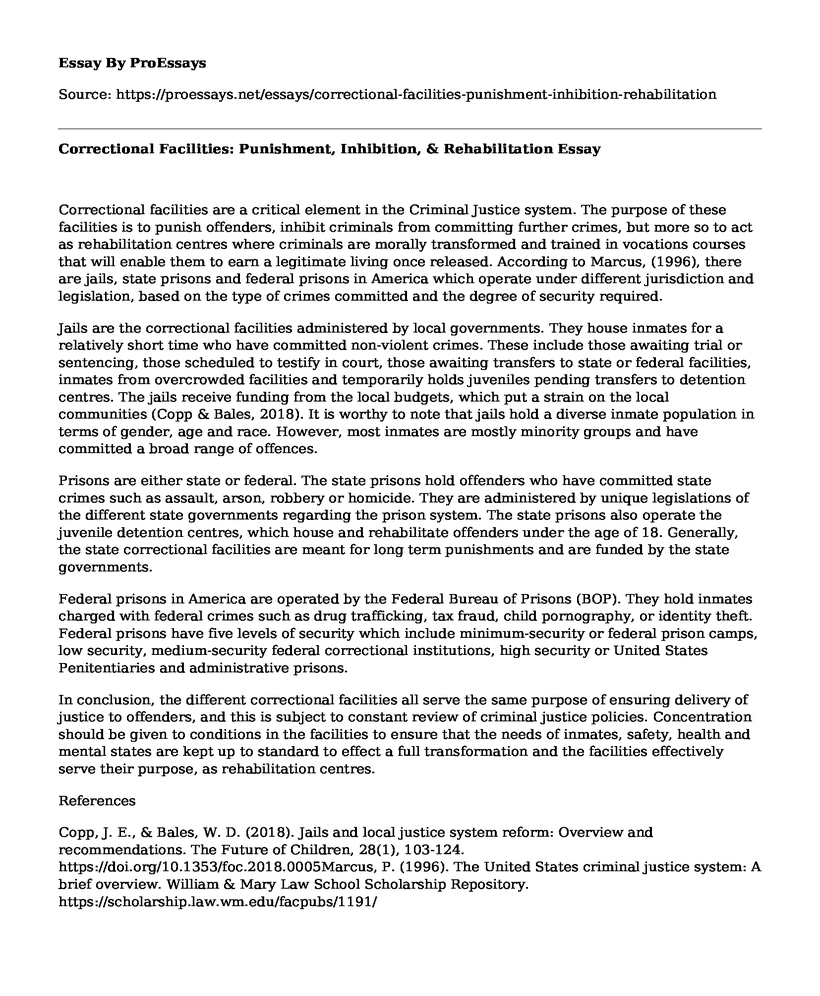Correctional facilities are a critical element in the Criminal Justice system. The purpose of these facilities is to punish offenders, inhibit criminals from committing further crimes, but more so to act as rehabilitation centres where criminals are morally transformed and trained in vocations courses that will enable them to earn a legitimate living once released. According to Marcus, (1996), there are jails, state prisons and federal prisons in America which operate under different jurisdiction and legislation, based on the type of crimes committed and the degree of security required.
Jails are the correctional facilities administered by local governments. They house inmates for a relatively short time who have committed non-violent crimes. These include those awaiting trial or sentencing, those scheduled to testify in court, those awaiting transfers to state or federal facilities, inmates from overcrowded facilities and temporarily holds juveniles pending transfers to detention centres. The jails receive funding from the local budgets, which put a strain on the local communities (Copp & Bales, 2018). It is worthy to note that jails hold a diverse inmate population in terms of gender, age and race. However, most inmates are mostly minority groups and have committed a broad range of offences.
Prisons are either state or federal. The state prisons hold offenders who have committed state crimes such as assault, arson, robbery or homicide. They are administered by unique legislations of the different state governments regarding the prison system. The state prisons also operate the juvenile detention centres, which house and rehabilitate offenders under the age of 18. Generally, the state correctional facilities are meant for long term punishments and are funded by the state governments.
Federal prisons in America are operated by the Federal Bureau of Prisons (BOP). They hold inmates charged with federal crimes such as drug trafficking, tax fraud, child pornography, or identity theft. Federal prisons have five levels of security which include minimum-security or federal prison camps, low security, medium-security federal correctional institutions, high security or United States Penitentiaries and administrative prisons.
In conclusion, the different correctional facilities all serve the same purpose of ensuring delivery of justice to offenders, and this is subject to constant review of criminal justice policies. Concentration should be given to conditions in the facilities to ensure that the needs of inmates, safety, health and mental states are kept up to standard to effect a full transformation and the facilities effectively serve their purpose, as rehabilitation centres.
References
Copp, J. E., & Bales, W. D. (2018). Jails and local justice system reform: Overview and recommendations. The Future of Children, 28(1), 103-124. https://doi.org/10.1353/foc.2018.0005Marcus, P. (1996). The United States criminal justice system: A brief overview. William & Mary Law School Scholarship Repository. https://scholarship.law.wm.edu/facpubs/1191/
Cite this page
Correctional Facilities: Punishment, Inhibition, & Rehabilitation. (2023, May 08). Retrieved from https://proessays.net/essays/correctional-facilities-punishment-inhibition-rehabilitation
If you are the original author of this essay and no longer wish to have it published on the ProEssays website, please click below to request its removal:
- Video Cameras in the Courtroom Essay
- Analysis Essay on the Three Strikes Law
- Essay Sample on Human Rights Tribunal of Alberta
- Gun Control Issues Essay
- Stories From the Court by Matthew Thomas Essay Example
- Essay Example on Social Construction: Understanding Meaning in Society
- Essay on Uncovering Invisible Alterations in Pen Inks With Document Examiners







